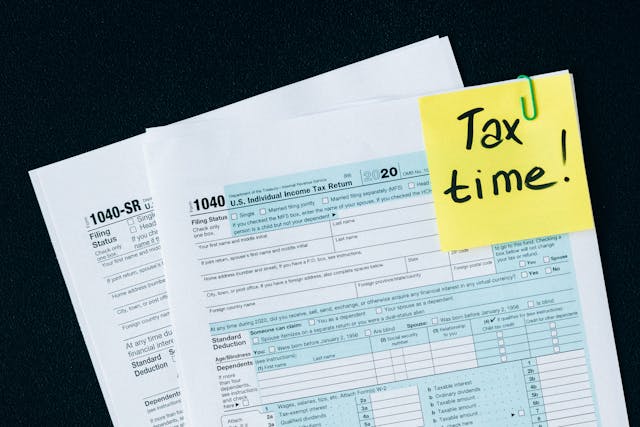We're a team of wedding, elopement and portrait photographers who put community over competition. We provide tips and resources for Photographers looking to up-level their businesses.
We're here to help When you join The Photography Business Academy
Taxes for Photographers – Introductory Guide
When you’re running a photography business, navigating taxes can feel overwhelming. But understanding the basics of taxes for photographers is crucial to keeping your business financially healthy and legally compliant.
This post will provide a quick overview of the most common types of taxes photographers need to pay, and we’ll touch on some of the questions that tend to come up frequently.
Keep in mind, we cover taxes (and all things finances for photographers) in more depth in our Financial Management Course for Photographers.

Why Understanding Taxes for Photographers is Important
Let’s be honest: taxes aren’t the most exciting part of running a photography business, but they are essential.
I feel like I have to say that quite a lot about a lot of business things!
Speaking from experience, you can do a lot of amazing things when you have a better understanding of your tax liability and how to take control over it.
In my shoes, I’ve been able to reduce how much money I pay in taxes (legally – if it needs to be said!) and instead use that money for things like investing and traveling more. In the past, I wasn’t always like this – and my first year in business I actually ended up getting hit with a huge tax bill because I poorly managed this part of my business…so if you’re in those shoes, I feel you!!
Anyways, by getting a good grasp on the taxes you’re responsible for, you can avoid penalties, plan for the future, and ultimately grow your business more strategically!
Of course, we always recommend consulting with a CPA or financial professional for personalized advice.
Even just an hour with a CPA can offer valuable insights that could save you money in the long run. Many photography businesses, as they grow, find it worthwhile to retain a CPA to help optimize their tax strategy.
The Most Important Taxes Photographers Need to Know About
As a photographer, there are several key taxes that you’ll need to account for.
Let’s break them down:
Federal, State, and Local Income Taxes for Photographers
Just like when you were employed at a regular job, you’ll still be required to pay income taxes.
However, as a business owner, these taxes are now calculated based on your earnings as a sole proprietor or as an incorporated business. The amount you owe can vary depending on your location, as some states don’t impose state income tax.
Accordingly to this survey by Nationwide Insurance, the average small business owner pays close to 20% of their gross earnings in income taxes.
Self-Employment Tax for Photographers
This one can be a bit of a surprise for new business owners!!
Self-employment tax covers contributions to Social Security and Medicare.
If you work a regular job (a W2 job), you have contributed to these things.
As a brief explanation of what these things are:
- Social Security – is a source of financial benefits through the government that is paid out typically around retirement age. People draw on social security based in part by how much they’ve contributed to it through their working life. Learn more through the Social Security Administration website.
- Medicare – provides health care coverage for low income and at risk populations. Learn more through the Medicare website.
As a business owner, you’re responsible for both the employee and employer portion of these taxes—totaling 15.3%.
While it can feel like an extra tax burden, it’s important to remember that these are programs most of us will benefit from later in life (…assuming nothing significant changes before then!).

W-2 Payroll Taxes for Photographers
If your business is set up with payroll (for example, if your business structure is set up to file taxes as an S-Corp), payroll taxes are automatically deducted from your paycheck and sent to the government.
These taxes typically cover income and self-employment taxes, but are handled differently because they’re processed through the payroll provider.
Sales Tax for Photographers
Depending on where you live, you may be required to collect and submit sales tax on your photography services or products (like prints and albums).
The rules around sales tax vary greatly depending on your state or local jurisdiction, so it’s important to know what applies to you.
As an example of sales tax in action – I have a photography business based in Pennsylvania. All sales made to other PA residents lead to a 6% sales tax being levied on top of my prices. So if someone was paying me $1,000 for a photography service, they’d be charged $1,000 + $60 (the sales tax) or $1,060 total. In some specific areas in PA, like Philadelphia, the tax is at a higher rate. A unique feature of my state is that I do not have to charge sales tax to someone who lives outside of the state (I often work with people in New Jersey and New York, for example).
Business Privilege Tax for Photographers
This is a more unique tax that some areas may require you to pay simply for having a business in a specific location.
The amounts are often minimal, but it’s still another piece of paperwork to stay on top of annually.
I share this one specifically because it directly impacts me (my township has this tax), while most of my photographer friends don’t have to worry about it!
With all this said –
These are the most common taxes, but keep in mind there is a lot of variation from place to place – so where you live and do business may have specific taxes not listed here.
As a side note, you also might not pay each of these taxes, either (for example – some states don’t have sales taxes). Again, doing your own research and consulting with an accountant is a great option if you are unsure of something.
How Much Should Photographers Set Aside for Taxes?
When it comes to estimating your tax burden, a good rule of thumb is to set aside 30% of your earnings.
This covers a safe margin for your federal, state, and local income taxes as well as self-employment taxes.
For example, if your photography business brings in $100,000, you should be prepared to pay around $30,000 in taxes. Keep in mind, this example is super simplified just to illustrate this point.
However, this number can vary – and for many reasons!
Many photographers find ways to lower their tax liability through deductions, such as business expenses or by contributing to tax-deductible accounts like SEP IRAs or HSAs.
How much you pay will also be influenced by whether your married (or not), have children, and more factors…
Our Finance for Photographers Course explores taxes in more detail and can help you identify ways to save money on your tax bill!
Saving for Taxes
It’s one thing to know how much you need to set aside for taxes, but another to make sure you actually have the money when it’s time to pay.
Here’s a tip: keep 30% of all your income in a separate account specifically for taxes. That way, you’re always prepared when tax season rolls around.
Some photographers also like to follow the “Profit First” (this is a link to the book on Amazon) methodology, which helps business owners organize their finances by setting aside money for specific purposes, like taxes, overhead, and profit. This can be a helpful way to stay organized, especially if managing money isn’t your favorite task. Profit First is a great book and one we recommend along with many other business books for photographers.
Paying Your Taxes
So, how do you actually pay your taxes?
The specifics depend on the tax. Here are a few common methods:
- Income and Self-Employment Taxes: You’ll generally pay these either quarterly or annually, depending on your earnings. Many photographers set up quarterly tax payments to avoid paying a lump sum at the end of the year. You can pay online through the IRS or your state’s tax portal. Some (or all) of these taxes may also be paid out through a payroll provider if your business is using one.
- Sales Tax: Most states that require sales tax have an online portal where you can log in and submit your payments monthly or quarterly.
- Business Privilege Tax: In many cases, you’ll receive a bill in the mail and can send in a check, though some areas may offer an online payment option.
No matter what taxes you’re paying, it’s crucial to schedule your payments ahead of time to avoid any late fees or penalties.
Bookkeeping and Taxes
Keeping good records is essential to ensuring you’re paying the right amount in taxes, too.
Bookkeeping, at it’s simplest, is keeping records of all your sales and expenses for your business. You will end up paying most taxes based on your net earnings (money you’ve made minus expenses).
By keeping good records, it will allow you to have an audit trail as well as clarity over your businesses financial situation.
If you need help with bookkeeping, consider using software like QuickBooks (which when configured well can be heavily automated and require an hour or 2 a month of your time) or outsourcing to a professional bookkeeping service.
Financial Management Course for Photographers
Want even more clarity on your taxes (and other money-matters)? Check out our Financial Management Course for Photographers. This course can be purchased individually or as a part of our full Photography Business Academy.

Honesty is a cornerstone of Shoot and Thrive, so we want you to know that some links in this post are affiliate links. This means we may earn a commission if you make a purchase—at no additional cost to you. We only recommend products and services we trust, have used ourselves, or have thoroughly researched based on industry feedback. Our goal is to provide solutions that genuinely help, whether they come from our direct experience or the collective knowledge of the photography community.
As photography business educators, we believe it's important for educators in this industry to be active photographers themselves. The images used throughout this website were taken through our photo studios - Hand and Arrow Photography and Marshall Scott Photography, except for stock images or if otherwise noted.
Turn Your Passion into a Thriving Business
Transform your photography business into a streamlined, profitable venture that gives you more time, freedom, and confidence.
With the Photography Business Academy, you’ll have a step-by-step guide to building the business—and life—you’ve always dreamed of. From branding to marketing, finances to client experience, we’ve got you covered.
Navigation
Shoot and Thrive is an ethically created resource for photographers needing mentorship, coaching, or business education. We believe in creating content that’s easy to digest and retain while incorporating educational best practices, so you gain clarity and confidence as a business owner.